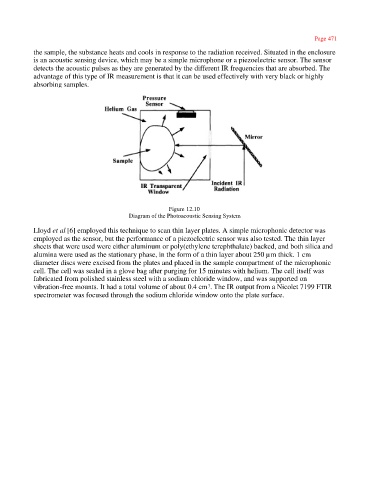Page 486 - Tandem Techniques
P. 486
Page 471
the sample, the substance heats and cools in response to the radiation received. Situated in the enclosure
is an acoustic sensing device, which may be a simple microphone or a piezoelectric sensor. The sensor
detects the acoustic pulses as they are generated by the different IR frequencies that are absorbed. The
advantage of this type of IR measurement is that it can be used effectively with very black or highly
absorbing samples.
Figure 12.10
Diagram of the Photoacoustic Sensing System
Lloyd et al [6] employed this technique to scan thin layer plates. A simple microphonic detector was
employed as the sensor, but the performance of a piezoelectric sensor was also tested. The thin layer
sheets that were used were either aluminum or poly(ethylene terephthalate) backed, and both silica and
alumina were used as the stationary phase, in the form of a thin layer about 250 µm thick. 1 cm
diameter discs were excised from the plates and placed in the sample compartment of the microphonic
cell. The cell was sealed in a glove bag after purging for 15 minutes with helium. The cell itself was
fabricated from polished stainless steel with a sodium chloride window, and was supported on
vibration-free mounts. It had a total volume of about 0.4 cm . The IR output from a Nicolet 7199 FTIR
3
spectrometer was focused through the sodium chloride window onto the plate surface.

